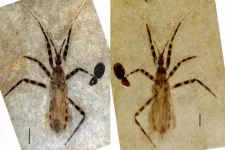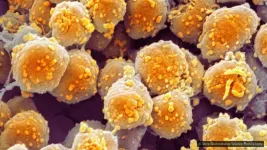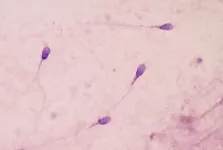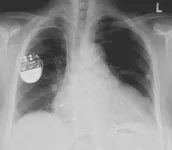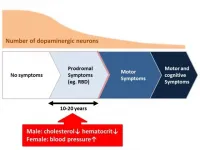(Press-News.org) CHAMPAIGN, Ill. -- The fossilized insect is tiny and its genital capsule, called a pygophore, is roughly the length of a grain of rice. It is remarkable, scientists say, because the bug's physical characteristics - from the bold banding pattern on its legs to the internal features of its genitalia - are clearly visible and well-preserved. Recovered from the Green River Formation in present-day Colorado, the fossil represents a new genus and species of predatory insects known as assassin bugs.
The find is reported in the journal Papers in Palaeontology.
Discovered in 2006 by breaking open a slab of rock, the fossilized bug split almost perfectly from head to abdomen. The fracture also cracked the pygophore in two. A fossil dealer later sold each half to a different collector, and the researchers tracked them down and reunited them for this study.
Being able to see a bug's genitalia is very helpful when trying to determine a fossil insect's place in its family tree, said Sam Heads , a paleontologist at the Illinois Natural History Survey and self-described fossil insect-genitalia expert who led the research with Daniel Swanson, a graduate student in entomology at the University of Illinois Urbana-Champaign.
Species are often defined by their ability to successfully mate with one another, and small differences in genitalia can lead to sexual incompatibilities that, over time, may result in the rise of new species, Swanson said. This makes the genitalia a good place to focus to determine an insect species.
But such structures are often obscured in compression fossils like those from the Green River Formation.
"To see these fine structures in the internal genitalia is a rare treat," Swanson said. "Normally, we only get this level of detail in species that are living today."
The structures visible within the pygophore include the basal plate, a hardened, stirrup-shaped structure that supports the phallus, he said. The fossil also preserved the contours of the phallotheca, a pouch into which the phallus can be withdrawn.
The find suggests that the banded assassin bugs, a group to which the new specimen is thought to belong, are about 25 million years older than previously thought, Swanson said.
"There are about 7,000 species of assassin bug described, but only about 50 fossils of these bugs are known," he said. "This just speaks to the improbability of even having a fossil, let alone one of this age, that offers this much information."
This is not the oldest fossil bug genitalia ever discovered, however.
"The oldest known arthropod genitalia are from a type of bug known as a harvestman that is 400-412 million years old, from the Rhynie Chert of Scotland," Heads said. "And there are also numerous fossil insects in amber as old as the Cretaceous Period with genitalia preserved.
"However, it is almost unheard of for internal male genitalia to be preserved in carbonaceous compressions like ours," he said.
The researchers named the new assassin bug Aphelicophontes danjuddi. The species name comes from one of the fossil collectors, Dan Judd, who donated his half of the specimen to the INHS for study.
INFORMATION:
The INHS is a division of the Prairie Research Institute at the U. of I.
The National Science Foundation supported this work.
Editor's notes:
To reach Sam Heads, email swheads@illinois.edu.
To reach Daniel Swanson, email drswanny@gmail.com.
The paper "A new remarkably preserved fossil assassin bug (Insecta, Heteroptera, Reduviidae) from the Eocene Green River Formation of Colorado" is available from the U. of I. News Bureau.
Simple vision tests can predict which people with Parkinson's disease will develop cognitive impairment and possible dementia 18 months later, according to a new study by UCL researchers.
The study, published in Movement Disorders, adds to evidence that vision changes precede the cognitive decline that occurs in many, but not all, people with Parkinson's.
In another new study published today in Communications Biology, the same research team found that structural and functional connections of brain regions become decoupled throughout the entire brain in people with Parkinson's disease, particularly among people with vision problems.
The ...
There are high hopes for the next generation of high energy-density lithium metal batteries, but before they can be used in our vehicles, there are crucial problems to solve. An international research team led by Chalmers University of Technology, Sweden, has now developed concrete guidelines for how the batteries should be charged and operated, maximising efficiency while minimising the risk of short circuits.
Lithium metal batteries are one of several promising concepts that could eventually replace the lithium-ion batteries which are currently widely used - particularly in various types of electric vehicles.
The big advantage of this new battery type is that the energy density can be significantly ...
New research suggests a unique program called Moms2B at The Ohio State University Wexner Medical Center shows a reduction in adverse pregnancy outcomes in communities disproportionately affected by these public health issues.
The study, led by researchers Courtney Lynch and Erinn Hade and published in the Journal of Maternal and Child Health, indicates that women who attended at least two Moms2B sessions may have lower rates of preterm birth, low birth weight and infant mortality compared to women who only received individual care.
"When we started the program 10 years ago, ...
New study identifies a bizarre new species suggesting that giant marine lizards thrived before the asteroid wiped them out 66 million years ago.
A new species of mosasaur - an ancient sea-going lizard from the age of dinosaurs - has been found with shark-like teeth that gave it a deadly slicing bite.
Xenodens calminechari, from the Cretaceous of Morocco, had knifelike teeth that were packed edge to edge to make a serrated blade and resemble those of certain sharks. The cutting teeth let the small, agile mosasaur, about the size of a small porpoise, punch above its weight, cutting fish in half and taking large bites from bigger animals.
Dr Nick Longrich, Senior Lecturer at the Milner Centre for Evolution at the University of Bath and lead author on ...
Clumsy kids can be as aerobically fit as their peers with better motor skills, a new Finnish study shows. The results are based on research conducted at the Faculty of Sport and Health Sciences of the University of Jyväskylä and the Institute of Biomedicine of the University of Eastern Finland, and they were published in Translational Sports Medicine.
Aerobic fitness doesn't go hand in hand with motor skills
According to the general perception, fit kids also have good motor skills, while low aerobic fitness has been thought to be a link ...
A group of international scientists, including an Australian astrophysicist, has used knowhow from gravitational wave astronomy (used to find black holes in space) to study ancient marine fossils as a predictor of climate change.
The research, published in the journal Climate of the Past, is a unique collaboration between palaeontologists, astrophysicists and mathematicians - to improve the accuracy of a palaeo-thermometer, which can use fossil evidence of climate change to predict what is likely to happen to the Earth in coming decades.
Professor Ilya Mandel, from the ARC Centre of Excellence in Gravitational Wave Discovery (OzGrav), and colleagues, studied biomarkers left behind by tiny single-cell organisms called archaea in the distant past, including the Cretaceous period ...
In the strawberry nursery industry, a nursery's reputation relies on their ability to produce disease- and insect-free plants. The best way to produce clean plants is to start with clean planting stock. Many nurseries struggle with angular leaf spot of strawberry, a serious disease that can result in severe losses either by directly damaging the plant or indirectly through a violation of quarantine standards within the industry.
Angular leaf spot is caused by the bacterial pathogen Xanthomonas fragariae. Current management strategies rely primarily ...
Chemotherapy and radiation treatments are known to cause harsh side effects that patients can see or feel throughout their bodies. Yet there are additional, unseen and often undiscussed consequences of these important therapies: the impacts on their future pregnancies and hopes for healthy children.
Extensive evidence shows that chemotherapy and radiation treatments are genotoxic, meaning they can mutate the DNA and damage chromosomes in patients' cancerous and noncancerous cells alike. When this occurs in a germline cell - which are egg cells in women and sperm in men - it can lead to serious fetal and birth ...
A new type of ultra-efficient, nano-thin material could advance self-powered electronics, wearable technologies and even deliver pacemakers powered by heart beats.
The flexible and printable piezoelectric material, which can convert mechanical pressure into electrical energy, has been developed by an Australian research team led by RMIT University.
It is 100,000 times thinner than a human hair and 800% more efficient than other piezoelectrics based on similar non-toxic materials.
Importantly, researchers say it can be easily fabricated through a cost-effective and commercially scalable method, using ...
A research team led by Nagoya University in Japan has found that blood pressure, the hematocrit (the percentage of red blood cells in blood), and serum cholesterol levels change in patients with Parkinson's disease long before the onset of motor symptoms. This finding, which was recently published online in Scientific Reports, may pave the way for early diagnosis and treatment of the disease.
Parkinson's disease, the second most common disease affecting the nervous system after Alzheimer's disease, is caused by a deficiency in a neurotransmitter called dopamine. It is known that more than half of all dopaminergic neurons are already lost in patients with Parkinson's disease in the stage wherein they ...
